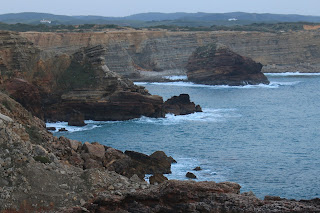Tucked away in the southwest corner of Europe, Portugal is an unassuming gem that has not yet received its due as a premier tourist destination. Before this trip, all I knew about Portugal was what I had learnt in social studies class in school - that it was the home of Vasco da Gama, the first European to land on India’s shores. With the promise of mild weather in the middle of February and a chance to go to the beach, a week long trip to Portugal was planned. This account also gives me a chance to showcase the photographic talents of my travel partner and all-around gentleman, Partha Chakrabarti.
Mary McCarthy, the American novelist wrote "Any Portuguese town looks like bride's finery - something old, something new, something borrowed and something blue". To discover that for ourselves, we planned a two part itinerary - first stop was the capital city of Lisbon and nearby Sintra followed by a road trip to the popular Algarve coast and back up to the monastery towns of Alcobaca and Batalha to complete the loop.

Befitting any European capital city, Lisbon has its modern side with excellent infrastructure, modern buildings and public transportation. But it is the Old town comprised of Alfama, Bairro Alto/Chiado and Baixa that exudes the charm of old world Portugal.

Narrow cobblestone roads lead up and down steep hills, tiny trams and funiculars jostling for space with tiny tuk-tuks whizzing past laid back pedestrians, spectacular tile work- azulejos- on walls of buildings topped with red terra cotta tiles, tiny houses squeezed next to restaurants serving bacalhau da bras, grilled sardines, arroz do mariscal and pasteis de natal. World famous retail chains sell trendy clothes and accessories next to old stores selling traditional painted ceramic roosters, cotton fabrics with intricate embroidery and lacework, tablecloths and purses made of cork, and tiles.
Tiles are everywhere is Lisbon. Elaborate nautical scenes painted on ceramic glazed tiles in blue and white, art deco patterns in brown and green, and biblical vignettes in red and gold adorn the walls of churches and office buildings alike. Whether it is the Cervejaria Trindade, a cavernous erstwhile monastery converted into a brewery and cheery beer hall or a fountain on the sunlit terrace in the Jardim Julio de Castilho, art here is expressed not just on canvas or linen but also on ceramic tiles.

Walking is certainly the best way to explore the alleyways of this charming old town is to walk and alleys, stopping at the numerous mirador-s (view points) and gardens and the small kiosks for a quick sip of delicious port wine.
 |
| Pic: Partha Chakrabarti |
 |
| Pic: Partha Chakrabarti |
With a 1,115 mile long coastline along the Atlantic Ocean, nautical exploration and naval might has featured heavily in Portugal’s history. The Caravel, a small highly maneuverable sailing ship along with two crows features in the coat of arms of Lisbon and the armillary sphere is present on Portugal’s flag. It was no surprise then that it was a Portguese explorer, Vasco Da Game who eventually succeeded in finding out the naval route to India. He is held in high regard everywhere is Portugal, especially in Lisbon. He is entombed in a shrine in the magnificent Jeronimo’s monastery in Belem and a large statue of him stands alongside that of Marquis de Pombal, on the arch at the Prada de Commercio. The Marquis was who was responsible for the quick and successful reconstruction of Lisbon after a massive earthquake flattened the city in 1755.
Jeronimo’s monastery is a splendid example of Portuguese Neo-Gothic Manueline style of architecture. Named after King Manuel I under whom it developed in the late 14h century, this decorative style employs intricately carved stonework in portals, niches, columns and ceiling featuring maritime themes, armillary spheres, botanical and Christian themes as well as images and influences from newly explored lands.

While the Praca do Commercio at the end of Baixa, a wide open square along the Rio Tagus, welcomes the visitors to this quaint and unassuming city, the Castelo do Sao Jorge stands guard at it’s highest point.

Dating back to the medieval times, this Moorish castle has been used by successive Portuguese royals as a residence and as a show of their military might. Though most of what remains now are ruins, this citadel complex offers some of the best views of the city of Lisbon.
A short 30 minute drive to mountains north of Lisbon took us to the town of Sintra. This small town hosts many of Portugal’s national monuments and has been classified as a UNESCO World Heritage site. Our destination has been described on the internet and guide books as 'Disney-esque', brightly colored castle on the top of a hill.
As the summer palace of the Portuguese royalty up until the early 20th century, the Pena Palace is an adorable dollhouse in bright red, yellow and blue, topped with domes, clock towers and terraces. Built in the Romantic style in the early 1800s, this national monument started its life as a chapel and monastery for the monks of the order of St. Jerome. After the earthquake of 1755, King Ferdinand II acquired the monastery and the land surrounding it and commissioned the construction of the present day palace. Moorish arches and domes are mixed with Neo-Manueline stone work on classic Gothic columns and topped with gargoyles. This is a fantasy land, where the best elements of art and architecture over two centuries is displayed with wild abandon. From the statue of Triton showing the allegory of creation to the arches of the Queen’s terraces, the beauty carries on inside as well. The Royal chapel with its exquisite alabaster carved altar, azulejos adorning every wall, stucco and masterfully painted walls and ceiling serve as phenomenal backdrop for exquisitely carved furniture and everyday objects.
































